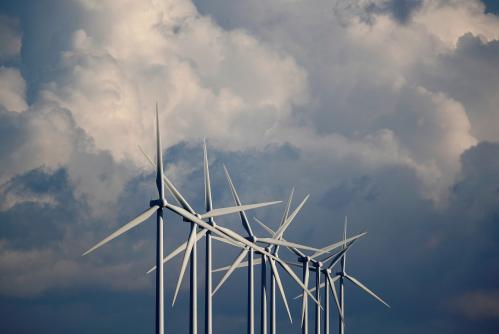 As the 24th Conference of the Parties (COP24) gets underway in Poland this week to finalize implementation guidelines for the Paris Agreement on climate, member countries and assembled experts would do well to emphasize the public and private capital needed to co-finance global sustainable infrastructure. Their task is more challenging and urgent than ever.
As the 24th Conference of the Parties (COP24) gets underway in Poland this week to finalize implementation guidelines for the Paris Agreement on climate, member countries and assembled experts would do well to emphasize the public and private capital needed to co-finance global sustainable infrastructure. Their task is more challenging and urgent than ever.
Every dimension of the climate change and global development agenda must shift from business as usual to urgent, an imperative made clear from the October report of the Intergovernmental Panel on Climate Change (IPCC) as well as in the Annual Statement on the State of the Climate Report issued by the World Meteorological Organization on November 29.
As the IPCC report warns, unless the world embarks on large-scale economic transformation to reduce greenhouse gas emissions, in approximately 10 years, average world temperatures will increase 1.5 degrees above pre-industrial levels, leading to more severe droughts, increased Arctic ice loss, a sea level rise, and further irreversible loss of biodiversity. There will also be significant health impacts. The World Health Organization estimates that 150,000 deaths annually are attributable to climate change; this is set to increase to 230,000 deaths by 2030. The global economic impacts will be profound too, with disproportionate fallout in the developing world.
So far, a key response to reducing emissions has been to price carbon. A carbon price should reflect the environmental externalities of producing and consuming carbon-intensive products, creating an incentive to invest in low carbon alternatives. A comprehensive carbon price consistent with decarbonization is essential. Yet existing carbon-pricing schemes do not price carbon high enough and remain piecemeal. Despite state-level carbon schemes in California and the Regional Greenhouse Gas Initiative—a cap and trade arrangement that includes New York and other mid-Atlantic states—there is no prospect of a federal carbon price. While the EU has a cap and trade scheme, it remains too low to drive needed economic transformation. Perhaps even more significantly, only a few developing countries have adopted a carbon price, yet are now responsible for over 60 percent of greenhouse gas emissions.
A focus on the role of private capital in addressing climate change by financing sustainable infrastructure is vital. As the 2014 New Climate Economy Report highlighted, the world needs to build around $94 trillion in new infrastructure out to 2030. This would be equivalent to a doubling of the world’s capital stock, with over two-thirds built in developing countries. Around 70 percent of global greenhouse gas emissions come from carbon-intensive infrastructure. As a 2015 study by Amar Bhattacharya and colleagues highlights, unless the new infrastructure is sustainable—featuring low carbon energy, energy efficient buildings, and mass transit systems—the world will lock itself into a high carbon pathway.
A 2017 OECD study found that investing in sustainable infrastructure can be good for growth and the climate. Building renewable energy instead of coal-fired power stations can reduce air pollution and lead to better health outcomes. Building compact cities with access to mass transit affects access to other key services such as health and education.
Yet budget constraints mean that public finance from governments and international organizations such as the World Bank are unable to meet global infrastructure needs. Therefore, increasing private investment into sustainable infrastructure is essential.
Globally, private capital abounds. A 2016 McKinsey study estimated there was $120 trillion in assets under management.
Yet allocations of capital into sustainable infrastructure remain low—at around 1 percent by institutional investors globally. The lack of private investment is due to the high risks of investing in sustainable infrastructure. In addition to permitting, construction, and market risks associated with infrastructure projects, sustainable infrastructure comes with other challenges. For instance, limited investment track records for new climate technologies such as offshore wind and thermal power generates technology risk. Reliance on government support, such as in the form of feed-in-tariffs or subsidies, creates political risk. Risks are even higher in developing countries, which often face political instability, poor investment environments, and currency risks.
Without action to reduce these risks, private capital will continue to flow into lower-cost but higher-carbon infrastructure projects.
Using public capital to reduce infrastructure risk can lower the cost of finance and boost rates of return, thereby crowding-in private sector capital. Multilateral development banks such as the World Bank have the knowledge and financial capacity to play a transformative role. As I detail in a recent working paper, this includes blending with concessional climate finance from the Green Climate Fund and the Climate Investment Funds by assuming a first loss position, thereby reducing risk for private capital and supporting innovative financial instruments such as green bonds.
Better allocation of capital in sustainable infrastructure also requires the private sector to report on the climate risk of high carbon infrastructure investments. Bank of England Governor Mark Carney and global investment giant BlackRock have emphasized the need for transparency by investors regarding exposure to climate risk. Climate risk includes the environmental impacts faced by investments as well as costs related to meeting climate-related regulations.
Ensuring the needed infrastructure we build for the future is sustainable will require partnerships that leverage public and private capital. In the absence of such partnerships, our ability to tackle global climate and development challenges will fall short.







Commentary
Sustainable infrastructure investment, climate change, and global development
December 3, 2018